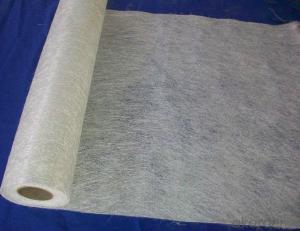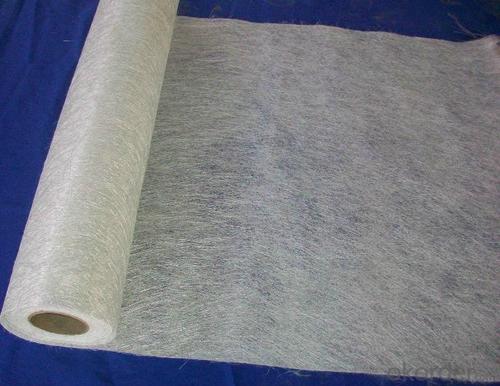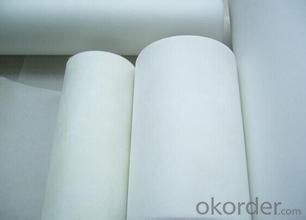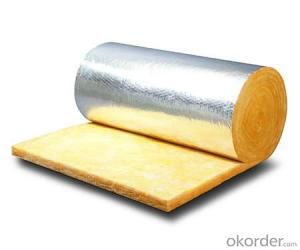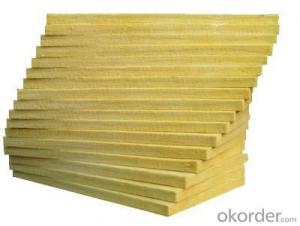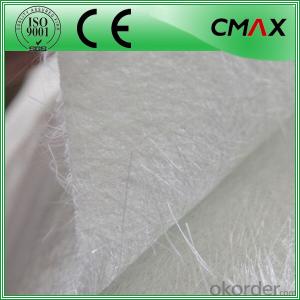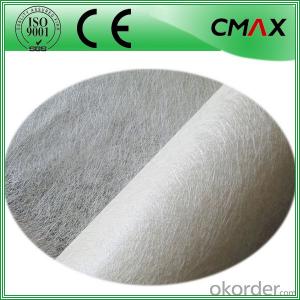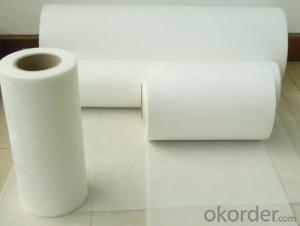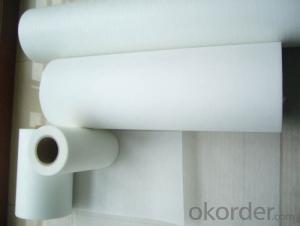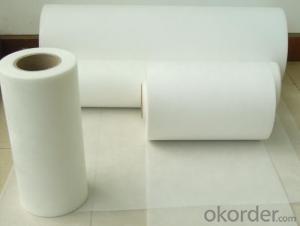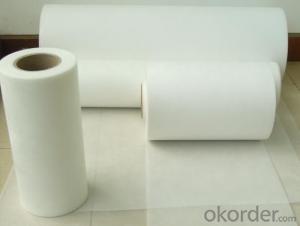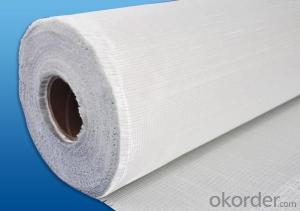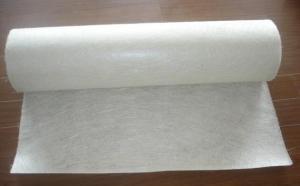Fiberglass Mat Tissue E-Glass Fiber Surface Tissue Mat for FRP Products
- Loading Port:
- Shanghai
- Payment Terms:
- TT OR LC
- Min Order Qty:
- 144000 m²
- Supply Capability:
- 1440000 m²/month
OKorder Service Pledge
OKorder Financial Service
You Might Also Like
1.Brief Introduction
E glass surfacing tissue is mainly used at the surface layers of FRP products.It can improve the product surface property on corrosion resistance, compressive strength, seepage resistance, and longer service life. It is also suitable for spraying; pattern pressing and other FRP pattern technology.
2.Product Features
Fast breakdown in styrene
Low binder content
Superior acid corrosion resistance
3.Technical Specification
Property | Area Weight | Moisture Content | Size Content | Breakage Strength | Width |
(%) | (%) | (%) | (N) | (mm) | |
Mathods | IS03374 | ISO3344 | ISO1887 | ISO3342 | |
S-SM20 | ±7.5 | ≤0.20 | 6-8 | ≥20 | 40-3000 |
S-SM30 | ≥30 | ||||
S-SM50 | ≥40 | ||||
S-HM20 | ≥20 | ||||
S-HM30 | ≥30 | ||||
S-HM50 | ≥40 |
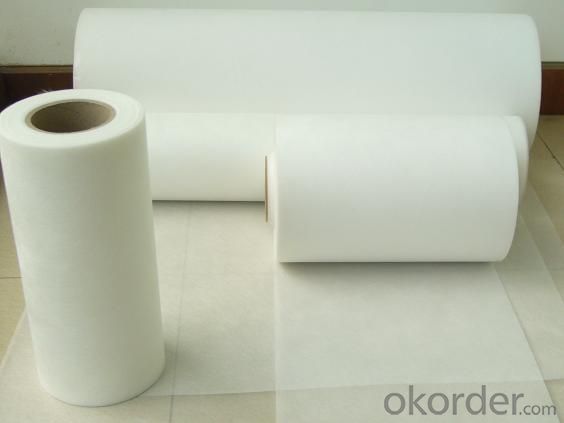
4.FAQ
Product Packaging:
Each Surface Tissue is wound onto a paper tube which has an inside diameter of 76mm and the mat roll has a diameter of 330mm. The mat roll is wrapped up with plastic film,then packed in a cardboard box or wrapped up with kraft paper.
Product Storage:
Unless otherwise specified, Chopped Strand Mat should be stored in a dry, cool and rain-proof area. It is recommended that the room temperature and humidity should be always maintained at 15℃~35℃ and 50%~75% respectively.
- Q: Is fiberglass mat tissue suitable for insulation in wastewater treatment plants?
- Yes, fiberglass mat tissue is suitable for insulation in wastewater treatment plants. It is a commonly used material for insulation due to its excellent thermal resistance, resistance to moisture and chemicals, and its ability to withstand high temperatures. Additionally, fiberglass mat tissue is lightweight and easy to install, making it an efficient choice for insulation in wastewater treatment plants.
- Q: How is fiberglass mat tissue used in the production of printed circuit boards?
- Fiberglass mat tissue is a commonly utilized reinforcement material in the production of printed circuit boards (PCBs). PCBs, consisting of copper layers, insulating materials, and fiberglass, are typically made in this way. The purpose of the fiberglass mat tissue is to provide structural support and mechanical strength to the PCB. Throughout the manufacturing process, the fiberglass mat tissue is saturated with epoxy resin, which forms a laminate material. This laminate is then combined with copper foils, serving as conductive pathways for the electrical signals on the PCB. The role of the fiberglass mat tissue in the performance and reliability of the PCB is crucial. It establishes a firm foundation for the copper layers, preventing delamination or warping due to mechanical stress or temperature fluctuations. Furthermore, it helps maintain the PCB's dimensional stability, ensuring its flatness and rigidity. Additionally, the fiberglass mat tissue enhances the PCB's resistance to heat and moisture. The epoxy resin used in the laminate provides excellent insulation properties, shielding the copper conductors from short circuits and electrical leakage. Furthermore, the fiberglass mat tissue acts as a barrier against moisture absorption, safeguarding the PCB from damage or malfunctions. In conclusion, fiberglass mat tissue is an indispensable element in the production of printed circuit boards. It offers structural support, improves mechanical strength, ensures dimensional stability, and enhances resistance to heat and moisture. Ultimately, the use of fiberglass mat tissue contributes to the overall reliability and performance of PCBs in various electronic devices.
- Q: Is fiberglass mat tissue suitable for insulation in high-rise buildings?
- High-rise buildings can benefit from the suitability of fiberglass mat tissue for insulation. This widely used material possesses exceptional thermal and acoustic properties, making it an ideal choice. Its lightweight and flexible nature, along with easy installation, ensure efficiency and effectiveness in high-rise structures. Furthermore, fiberglass mat tissue boasts excellent fire resistance, a crucial requirement for multi-story buildings. It also resists moisture, mold, and pests, ensuring durability and optimal performance. Customization for walls, floors, and ceilings allows consistent insulation throughout the entire building. In conclusion, fiberglass mat tissue is a dependable and cost-effective insulation solution for high-rise buildings.
- Q: Is fiberglass mat tissue compatible with different resin systems?
- Fiberglass mat tissue is indeed compatible with different resin systems. This versatile material can be utilized with a variety of resin systems, such as polyester, epoxy, and vinyl ester resins. Its exceptional wet-out properties enable the resin to be absorbed and distributed evenly throughout the mat. Consequently, this compatibility facilitates the fabrication of robust and long-lasting composite structures for numerous industries, including automotive, marine, construction, and aerospace. Nevertheless, it is crucial to carefully assess the unique properties and characteristics of the resin system employed to guarantee optimal performance and compatibility with the fiberglass mat tissue.
- Q: Can fiberglass mat tissue be used for swimming pool construction?
- Certainly, fiberglass mat tissue is suitable for the construction of swimming pools. This versatile material is widely utilized in the construction sector due to its robustness, durability, and ability to withstand water and chemicals. Its primary purpose is to reinforce the swimming pool shells, thereby enhancing their structural integrity and preventing any potential issues like cracking or leakage. Moreover, fiberglass mat tissue is renowned for being lightweight and easy to manipulate, which contributes to its popularity among pool builders. Nonetheless, it is crucial to ensure that the fiberglass mat tissue employed in swimming pool construction adheres to the required standards and regulations in order to guarantee the pool's safety and longevity.
- Q: Is fiberglass mat tissue suitable for insulation in sports facilities?
- Fiberglass mat tissue is indeed suitable for insulation in sports facilities. Fiberglass is a commonly used material for insulation due to its excellent thermal properties and fire resistance. It provides effective insulation, keeping the indoor environment comfortable by reducing heat loss or gain. Additionally, fiberglass insulation is lightweight, durable, and easy to install, making it ideal for sports facilities where large areas need to be insulated. It is also resistant to moisture and does not promote the growth of mold or mildew, ensuring a healthy and hygienic environment. Overall, fiberglass mat tissue is a reliable and efficient option for insulation in sports facilities.
- Q: Can fiberglass mat tissue be used for roofing?
- Yes, fiberglass mat tissue can be used for roofing. It is commonly used as a reinforcement material for roofing systems due to its high strength and durability. It helps to enhance the structural integrity of the roof and improve its resistance to weathering and other external factors.
- Q: How is fiberglass mat tissue used in the aerospace industry?
- Due to its exceptional properties and versatility, fiberglass mat tissue finds extensive use in the aerospace industry. It plays a crucial role in the manufacturing and maintenance of aircraft, serving various purposes. One of the primary applications of fiberglass mat tissue in the aerospace industry lies in its incorporation into composite materials. These materials, formed by combining two or more substances, are widely employed in aircraft construction to reduce weight while ensuring structural integrity. In composite laminates, fiberglass mat tissue acts as a reinforcement material, providing strength, stiffness, and dimensional stability. Consequently, it is suitable for various components such as wings, fuselage, and tail sections. The high tensile strength of fiberglass mat tissue guarantees that the composite structure can withstand the demanding conditions faced in the aerospace industry. Moreover, aircraft repair and maintenance extensively utilize fiberglass mat tissue. This material is commonly employed in the process of composite patching, which involves the restoration of damaged or worn-out composite components. By impregnating the fiberglass mat tissue with resin and applying it to the affected area, strength is restored and structural integrity is regained. This technique is widely employed for repairing aircraft components like fairings, radomes, and other composite parts, ensuring their safe and reliable operation. Additionally, fiberglass mat tissue finds application in the insulation of aircraft. It is used as a thermal and acoustic insulator in critical areas of the aircraft, including the interior cabin. By reducing heat transfer and preventing condensation, fiberglass mat tissue helps maintain a comfortable environment for passengers and crew. Furthermore, its sound-absorbing properties minimize noise levels inside the aircraft, ultimately enhancing the overall travel experience. In summary, fiberglass mat tissue is an essential material in the aerospace industry. Its exceptional properties, including high tensile strength, dimensional stability, and thermal/acoustic insulation capabilities, make it an ideal choice for a wide range of applications. From composite structures to aircraft repair and maintenance, fiberglass mat tissue proves indispensable in ensuring the efficiency and safety of aerospace operations.
- Q: Can fiberglass mat tissue be used for making insulation panels?
- Indeed, insulation panels can be manufactured using fiberglass mat tissue. This lightweight and flexible material possesses remarkable thermal insulation characteristics. Typically, it is utilized as a reinforcing layer during the production process of insulation panels. By doing so, the mat tissue not only fortifies the panels, but also ensures efficient insulation against heat transfer. Moreover, fiberglass mat tissue exhibits resistance against moisture, mold, and mildew, rendering it highly suitable for insulation purposes.
- Q: How does the width of fiberglass mat tissue affect its installation?
- The width of fiberglass mat tissue affects its installation by determining the amount of coverage it provides per roll. A wider mat tissue will cover a larger area with each roll, reducing the number of rolls needed for installation. This can save time and effort during the installation process. Additionally, a wider width may also provide better overall strength and stability to the installed fiberglass mat tissue.
Send your message to us
Fiberglass Mat Tissue E-Glass Fiber Surface Tissue Mat for FRP Products
- Loading Port:
- Shanghai
- Payment Terms:
- TT OR LC
- Min Order Qty:
- 144000 m²
- Supply Capability:
- 1440000 m²/month
OKorder Service Pledge
OKorder Financial Service
Similar products
Hot products
Hot Searches
Related keywords
